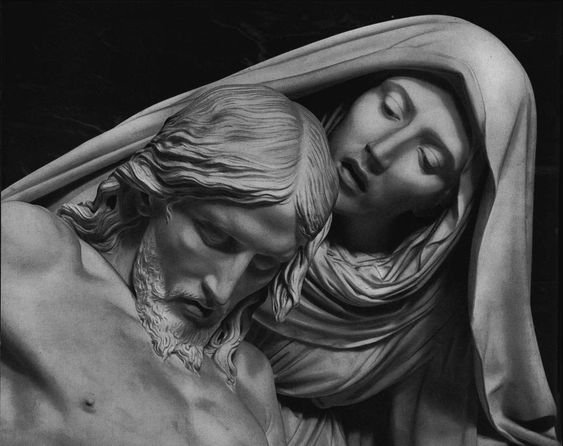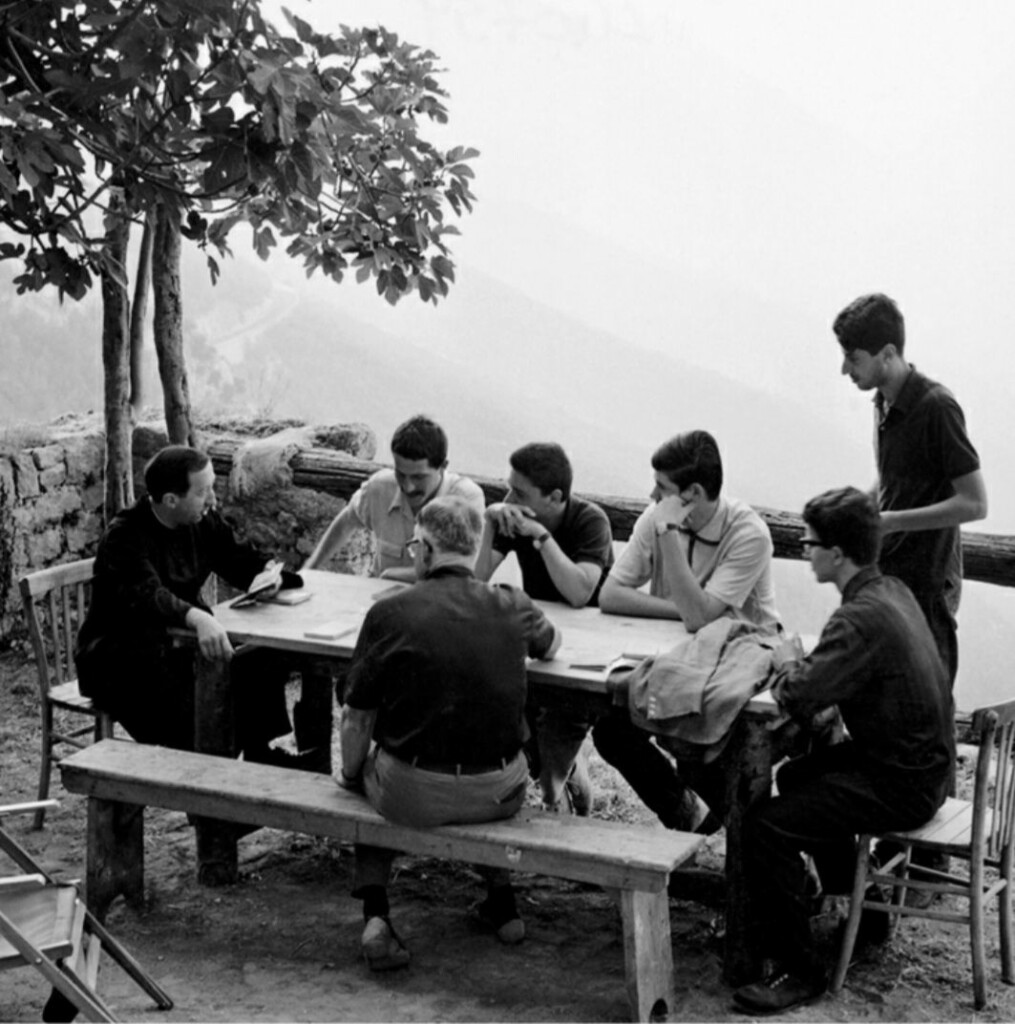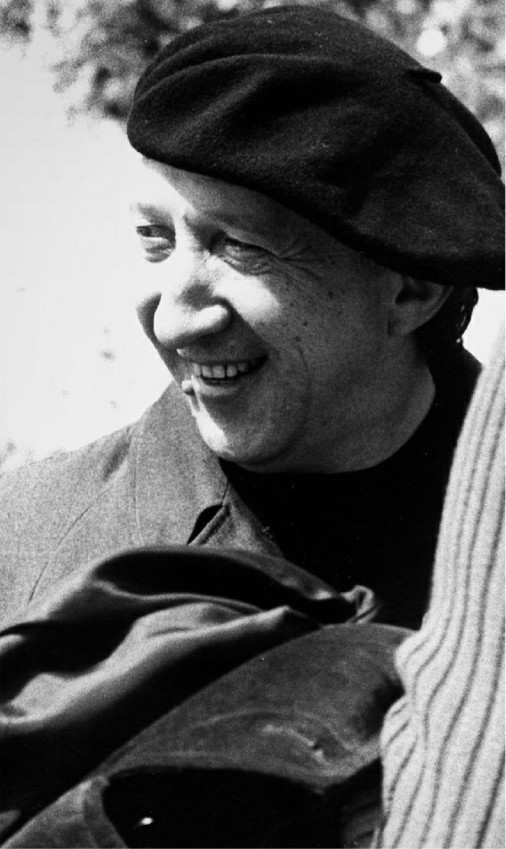
Pietà (detail), by Giovanni Duprè, 1867, Siena, Cimitero della Misericordia (Cemetery of Mercy). The moment when the body of Jesus is taken down from the cross and given to his mother, Mary, for burial, is the moment of the intersection of the deepest love, deepest faith and deepest sorrow in our tradition, and so, in our experience of our faith… Our faith is a memory of this moment, or perhaps better, of this moment transfigured by the coming announcement of… the Resurrection

Don Luigi Giussani (left) with young Italian Catholics and one American artist sometime in the 1960s near Subiaco in central Italy, not far from Rome, where both St. Benedict in about 500 A.D. and Blessed Lorenzo in about 1200 A.D. lived in a cave. The cave is still able to be visited today…
“I was told: everything must be welcomed without words and held in silence. Then I realized that perhaps my entire existence would pass in realizing what had happened to me. And your memory fills me with silence.” –Lorenzo the Hermit, c. 1215 A.D., speaking of his mystical encounter with Risen Christ. Lorenzo, after killing a man, spent the rest of his life in penance for his sin. He came to Subiaco, where St. Benedict had stayed in a cave 700 years earlier, and there he stayed. He is thought to have met St. Francis when St. Francis visited Subiaco in the early 1200s. He was later declared Blessed. The words of Blessed Lorenzo the Hermit were often cited by Don Luigi Giussani (1922-2005), the Italian priest famous for his work with Italy’s young people, starting in Milan in the 1950s, work which led to the creation of the Communion and Liberation (CL) movement. The words are cited in a book entitled Generare tracce nella storia del mondo (“Generate traces (or paths) in the history of the world”) by Luigi Giussani, Stefano Alberto and Javier Prades, Milan, 2019, p. 54 (link, link, link and link)
“As the days have passed, we know more and more why we have republished La vie contemplative: son rôle apostolique (“The contemplative life: its apostolic role,” link and link), by an anonymous Carthusian monk: we need to react to the deadly confusion that dwells in the Christian people, poisoned by a false naturalist Christianity, which still using Catholic words empties them of true meaning. It is a confusion at all levels, at all levels of the hierarchy and of the people. It is a poisoning that spreads death, the death of fully-lived Christianity.” –-La Corsia dei Servi (“The path of the servants”), a small group of Italian Catholics led by Dr. Stefano Arnoldi, who initiated the group in May 2011 after meeting with the late Cardinal Carlo Caffara (1938-2017) (link and link)
“The following year, 1967, Giussani spoke of pain as the most ‘qualifying’ experience of the human condition. There are two ways to escape this evidence, he said. The first is the ‘superficiality’ of not thinking about it, ‘an abandonment of yourself to time to dry up your conscience.’ The second is to throw oneself headlong into work, ‘man is led to hope that the redemption of pain comes from his activity.’ Instead, Christian maturity is ‘fixing our eyes on Christ’ because ‘salvation does not come from our works and the structures we make, it comes from God and it is a story.'” —Lucio Brunelli, “Quell’eremo che fu caro a don Giussani” (“That hermit who was dear to don Giussani”), October 13, 2022 (full text below)
Letter #158, 2023, Tuesday, November 21: Silence
In between Vatican trials, and more or less helpful responses to “dubia,” and the appointing and firing of Spirit-filled or Spirit-challenged bishops, beneath and beyond all of this, there remains… Christ.
There remains the Logos of God, the reason of our and every universe, the meaning of all things.
The Word of God.
Who exchanged His divinity for our humanity.
And therefore made it possible for us… to exchange our humanity for His divinity.(!)
***
The structure of the Church, the institution we call “Roman Catholicism” with its rites and laws and vestments and rituals, its hierarchy and it saints, its many works of charity and kindness over the centuries, its social, cultural and political importance for nearly two millennia, is something, humanly speaking, impressive, even astonishing and, in many ways, profoundly attractive, but the supreme law of this structure, this institution, is, arguably, not the “self-referential” health and increase of the Church and its structures, but rather the salus animarum — the salvation of souls.
One by one. Each soul utterly unique. Each of infinite worth.
The salvation of a soul is something invisible: it is the reconciliation of one unique, irrepeatable human soul with the soul’s creator, with the divine author and source of all being, God, one and triune.
This salvation, this ending of the rupture, or lost connection, between the soul and it’s creator, is something profound, important, and more intimate than any other human intellectual, social or physical encounter.
The Lord told His disciples that he would make them “fishers of men.”
This is what he meant: that the disciples would catch, and care for, and save, souls.
***
This morning, I happened to come across a piece on the internet which speaks about this matter, this “salvation of souls,” this bringing of souls to know, love and serve Christ.
The piece, dated more than one year ago (October 13, 2022) is a blog post written by a colleague and friend of mine from the “old days” — the late 1980s, when we worked together at the magazine 30 Giorni (30 Days). The author is the distinguished Italian journalist and Vaticanist Lucio Brunelli.
Here is his blog post. —RM
That hermitage that was dear to Don Giussani (link)
By Lucio Brunelli
October 13, 2022
The window of the cell, carved into the rock, overlooks an autumn landscape of yellow leaves and dense woods. Down there, between smooth rocks and wild vegetation, the little river Aniene flows. But the stream is far away and the quiet of the hermitage is not violated even by the murmur of its current. As far as the eye can see, there are no houses, no cars, no traces of human presence, only primitive nature. And a great silence.
It’s a long story. An Apulian knight named Lorenzo killed a man during an argument and spent the rest of his life atoning for his sin. It was the year of the Lord 1209. First he made a long pilgrimage to the sanctuary of Santiago de Compostela. Then he knocked on the door of the monastery founded in Subiaco by St. Benedict. The monks welcomed him but his torment did not subside and he asked the abbot for permission to live in a hermitage in the mountains just above the monastery. He prayed and did penance. He slept in a bed dug into the rock and ate herbs.
His superiors had to command him not to be so severe with himself, because God shows mercy even to a murderer, when he sees that his heart is repentant.
They say he was still alive when a man named Francesco [Francis of Assisi] with his habit all patched up and already venerated as a saint during his lifetime, came from Assisi to visit the Sacro Speco of Subiaco.
A local historian, Aldo Innocenzi of Roviano, ventures a suggestive hypothesis: that it was on that occasion, having in his eyes and heart the emotion of the meeting with St. Francis, that Lorenzo uttered those words much loved by Don Giussani and by him quoted many times, preaching to his young people: “I was told, everything must be accepted without words and held in silence. Then I realized that perhaps my entire existence would pass in realizing what had happened to me. And your memory fills me with silence.”
Eight centuries passed from the death of the hermit Lorenzo whose virtues the Church later recognized, proclaiming him blessed. There were no longer men of God willing to live among that stone, landslides made access risky, brambles enveloped that holy abode.
(…)
Don Giussani began to frequent the hermitage that belonged to Blessed Lorenzo with a small group of young people. To reach the hermitage you had to follow a little-traveled path; by car you could get to the Sacro Speco di Benedetto, then you had to go up on foot.
But who are the young people who follow Don Giussani into these rugged mountains, where Benedict of Norcia lived as a hermit before founding an extraordinary monastic movement? They are boys and girls who have lived the experience of Student Youth and are now asking Don Giussani for help in verifying a desire that arose spontaneously in their lives: to consecrate their entire existence to God, remaining immersed in the world. It is the nascent cocoon of that weaving of Christian life which will later take the name of Memores Domini [“Rememberers of the Lord”]
At the beginning Don Giussani wasn’t very convinced, it was the boys who insisted. In an interview we conducted for the monthly 30 Giorni, he remembered that beginning like this: “A long time ago, at the beginning of the 60s, some young people from Student Youth insisted that they be followed in living a dedication to God within the world. The proposal struck me as admirable, but I did not immediately implement it. So much so that, at the beginning, I participated not very passionately in their fortnightly prayer meetings, and only after a period of two or three years did I clearly realize that that could be a provocation to a particular but significant realization of the Christian experience we began years ago.”
Few people know it, even among the members of Communion and Liberation, but the first gathering for the spiritual exercises of the “Adult Group” (it was initially called that) was held in the hermitage of Blessed Lorenzo, in the summer of 1966.
Reviewing the black and white photos, we are struck by the faces of these young people from the good Lombard bourgeoisie, so determined in their desire and so fascinated by Don Giussani that they faced the conditions that were not exactly comfortable accommodation in the hermitage. In the cells there was no running water and above all there was no electricity.
One of those girls, Giuletta Loreti, tells Alberto Savorana in his documented biography of Don Giussani: “We had to go up with the briefcase on foot, because there were only paths. Giussani went around with the Baygon [insect repellant] in his pocket, because he was allergic to little insects. We listened to his lessons outdoors, around a table where we also ate.” (…)
Don Giussani was still wearing his cassock, the Second Vatican Council (1962-1965) had just ended, and the novelty of the black clergyman suit had not made headway, but the free experience of these boys, their desire for an evangelical radicality, condensed better than many clerical disputes the dream of a Church more alive and able to speak to the men of today that John XXIII had moved.
For some years — from 1966 to 1970 — every summer in the hermitage of Blessed Lorenzo the spiritual exercises of the “Adult Group” were repeated. They were particular years in the history of Don Giussani. The Communion and Liberation movement had not yet been born (it was born in 1971) and the experience in Student Youth had encountered some resistance in the ecclesiastical world: in 1965 Giussani had been sent to the United States to continue his academic studies, a kind way in which sometimes bishops “exile” for a period experiences that are not entirely welcome. He only stayed in America for a few months but by then GS was marking time and the impetuous wind of the student revolts of ’68 would have hastened the crisis.
But life pulsated, indeed, in the summer gatherings that marked the history of the Memores domini. Giussani was not worried about the “form” to give to this absolutely new experience in the Church: monks without religious habit, the evangelical counsels (poverty, chastity, obedience) lived not in places protected from the seductions of the world but in the midst of the world; working like other men but placing goods in common and all of life in the hands of God.
It was more the young people who asked to give a shape to this experience, Don Giussani only wanted to help their path, taking care to lay solid foundations. “Relationship between me and God… Every other way of conceiving the vocation ends up being, to a greater or lesser extent, an alienation,” he said in the first spiritual exercises of 1966. Traces of all these conversations remain in the CL archives.
The following year, 1967, Giussani spoke of suffering as the most “qualifying” experience of the human condition. There are two ways to escape this evidence, he said.
The first is the “superficiality” of not thinking about it, “an abandonment to time to dry up the conscience.”
The second is to throw oneself headlong into work, “man is led to hope that the redemption of pain comes from his activity.” Instead, Christian maturity is “fixing our eyes on Christ” because “salvation does not come from our works and the structures we make, it comes from God and is a story.”
(…)
As the years passed, the members of the adult group became more and more numerous and it was no longer possible to hold spiritual exercises in the guesthouse of the hermitage which could accommodate a maximum of thirty people. A new hermit, Alberto, went to settle in the home of the blessed Lorenzo and at times still resides there, when landslides do not block the path that Don Giussani followed on foot with his young men.
A few months ago, with some friends from Rome we were able to visit the hermitage. Nature is always uncontaminated, the great silence is not disturbed by anyone. In the cells dug into the rock we found, still intact, the books that were there in the 1960s. We were all overcome with emotion, it came naturally to recite a prayer together, thinking back to the wonderful story that passed under that spur of rock, from which, a little further down, you can see the place where Western monasticism began.
On December 22, 1968, commenting on the opening of the first house-monastery of the Adult Group in Gudo, in the Lower Milan area and perhaps having images of Subiaco in his eyes, Don Giussani said: “The sign of the times is that the vocation of the Christian is a vocation to immanence in the world. It is the time of the Benedictine monastery, when the monks went out among the barbarians and helped them cultivate the land.” Happy centenary in heaven, Don Giussani…
[Note: Born in 1922, the year 2022 (when this blog post was written) marked 100 years since the birth of Don Giussani.]
[End, Lucio Brunelli blogpost]

Italian priest, writer and “fisher of souls”: the late Don Luigi Giussani (1922-2005)





Facebook Comments